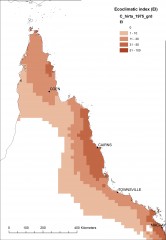NERP TE Project 7.2 - Invasive species risks and responses in the Wet Tropics (CSIRO)
Project summary
This project focuses on understanding the current and future risks and responses of invasive species in the Wet Tropics. The aim is to develop a strategic approach to pest management that considers the complexity of ecological processes involved with establishment and spread and takes account of the values and assets in the region. The project will contribute to the management of invasive plants and animals by providing prioritisation tools that align with existing regional pest management frameworks.
Why this research is needed
Pest management planning in the Wet Tropics is primarily based on knowledge about current pest distributions and risks. Land managers in the region have identified the need to also consider potential future risks in strategic planning, taking into account pathways of spread, climate change and emerging or sleeper weeds and pests. However, there is a gap in our understanding about how to forecast future risks and responses and how to integrate them in existing management planning. This research project addresses this gap and provides tools for pro-active and strategic management of pests, considering current and future risks and responses.
Research-user focus
The project will address high priority research needs of state and Australian Government agencies as well as providing information for conservation planners/managers. Research-user organisations include the Department of Sustainability, Environment, Water, Population and Communities, Biosecurity Queensland, Queensland Parks and Wildlife Service, the Wet Tropics Management Authority, Far North Queensland Regional Organisation of Councils and Terrain NRM.
Outcomes
This project will improve understanding of how invasive species become established and spread in the Wet Tropics and identify strategic approaches for prioritising management activities at a regional scale, and allocating resources and effort on the ground.
Specifically, the project will identify:
- Networks of weed and pest animal spread throughout the Wet Tropics.
- Geographic areas and natural assets particularly at risk from invasive species
- Emerging weed threats in the Wet Tropics as a result of climate change.
- Strategic management options for minimising current and future impacts from invasive species.
The project has the potential to reduce the long-term cost of pest management in the Wet Tropics by forecasting future risks and responses and establishing pro-active and strategic management approaches for minimising future impacts.
Reports, Publications and News
For more information see Project 7.2 'Invasive species risks and responses in the Wet Tropics' on the NERP Tropical Ecosystems Hub site.
Datasets

This dataset shows the projected current and future (2070) climatic suitability for the invasive plant species Clidemia hirta, Hiptage benghalensis, Miconia calvescen, Miconia nervosa, Miconia racemose, Stevia ovata,and Turbina corymbosa across North Queensland. Modelled using CLIMEX.
Method:
This project focuses on understanding the current and future risks and responses of invasive species in the Wet Tropics. The aim is to develop a strategic approach to pest management that considers the complexity of ecological processes involved with establishment and spread and takes account of the values and assets in the region. The project will contribute to the management of invasive plants and animals by providing prioritisation tools that align with existing regional pest management frameworks.





